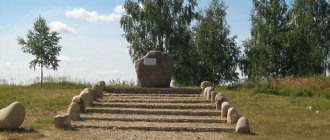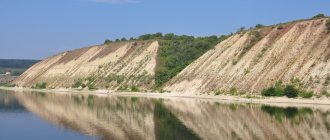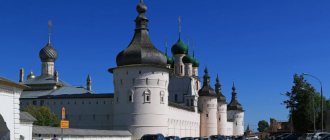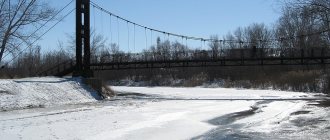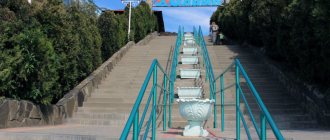The history of Smolensk begins along with the history of the Old Russian land. According to one version, the name of the city on the Dnieper comes from the Slavic designation for the black, swampy land on which the city was built - smol. Others claim that the city's inhabitants produced resin to strengthen boats. They were called Smolensk.
In 882, Prince Oleg annexed Smolensk to his lands, uniting two centers under his rule - Kyiv and Novgorod.
All events that took place in Russian and Russian history were one way or another reflected in the history of this city.
The formation of statehood, the great “zamyatnya” (civil strife), the Time of Troubles, the Napoleonic invasion and the Great Patriotic War. It is enough to walk around the city and get acquainted with its sights - history comes to life.
- Guide to the Smolensk region: what else you must visit besides Smolensk itself.
- If you are traveling to Smolensk by car from Moscow, you can stop at two interesting cities along the way - Mozhaisk and Vyazma.
Historical sites and museums
Stone Smolensk Fortress
The Smolensk Kremlin (a more correct definition is a fortress wall) was built at the turn of the 16th and 17th centuries. Architect Fyodor Kon was able to solve a difficult problem - to build a defensive structure and create a wonderful example of stone architecture.
The built fortress was distinguished by a three-tier battle system:
- For plantar combat - rectangular stoves with cannons
- For the middle battle there are vaulted chambers in the center of the wall
- For the top one - blind and combat teeth on the upper platform
Another feature of the fortress was and is its towers: no two of them were alike, each was built taking into account its purpose and relief. Of the 39 towers, 18 have survived today.
Several fragments of the 6.5 km fortress wall have survived. Most of it was destroyed in 1812 by Napoleon's soldiers.
Veselukha Tower
On a high hill, the Veselukha Tower looks into the distance.
Legend has it that the builders (a crack in the wall of the tower appeared again and again), at the instigation of the sorceress, sacrificed the most cheerful and beautiful girl in the city. When the girl was walled up in the wall, the crack disappeared. The restless spirit of the girl appears as a ghost and either cheerful laughter or ominous laughter is heard.
Not only the legend is impressive, but also the view from this tower: hills in the greenery of trees, the Dnieper, the domes of churches.
Eagle Tower
The most monumental of the surviving ones is the Eagle (Gorodetskaya) tower. It was destroyed twice during sieges and wars in the 17th century and rebuilt.
In the mid-18th century, counterfeiter Count Zmeyavsky organized “performances” of evil spirits on the walls of the tower to cover up his illegal activities. At that time, there were bad rumors about the tower, and the inhabitants of these places were afraid.
The gang was defeated, the underground passages were filled up.
Thunder Tower
Address: October Revolution Street, 3 Website: https://www.krepost-smolensk.ru Opening hours: 10:00 – 18:00 Tuesday - Friday Cost: 80 rubles
This is the only tower that you can get into. It houses the Smolensk - Shield of Russia museum, dedicated to the military history of the city. On the third tier there is a functioning observation deck.
Nikolsky Gate of Smolensk
Address: Gagarina Avenue, 19-a Working hours: from 10.00 to 18.00 weekends - Sat, Sun Telephone:
Smolensk fortress walls began to be built around Smolensk under Tsar Fyodor Ioannovich. One of the first Russian architects, Fyodor Kon, built walls 6 m thick. Each tower had its own purpose. Nikolskaya served as a passage to the fortress. It was through it that Emperor Napoleon entered Smolensk.
Initially, the tower was called Elenevskaya - after the village of Yelnya. It could be reached by the road leading out of the fortress. The name Nikolskie was assigned to the tower in the 18th century, when the Church of St. Nicholas was erected nearby. During this period, the gate was crowned with an icon depicting a saint.
Currently, a busy city highway passes through the Nikolsky Gate. A through passage appeared in the wall in 1902, when a tram was launched in the city. The real gate is now protected by bars and represents a corridor through the Nikolskaya Tower. The tower today houses the collection of the Flax Museum.
A wooden staircase leads to the top of the tower. The passage there is closed.
Museum "Smolensk - Shield of Russia"
Address: st. October Revolution, 3, bldg. 1 Opening hours: 11.00-19.00 Tue-Sun, closed on Mon Ticket price: from 100 rubles Telephone:
The Museum of Military History of the Russian Military Historical Society “Thunder Tower” (the name was assigned in 2021) is located in one of the 22 fortress towers of Smolensk that have survived to this day. The Thunder Tower was built in the 17th century. You can get to the top via an internal steep staircase. From the lookout platform on the 4th floor there is a panoramic view of Smolensk. An observation deck is also located on the 3rd floor in the hall where military equipment and clothing of 13th century warriors are displayed.
The exhibition on the 1-2 floors of the museum tells about the construction of the fortress wall around the city. Materials are demonstrated about the defense of Smolensk during the 20-month siege of the fortress in the Time of Troubles. The museum contains a large collection of historical objects from the 16th and 17th centuries: building materials and tools, military armor. Visitors will learn about the history of wars and peace treaties of Smolensk in the 17th century.
The museum exhibits a model of the Smolensk fortress, made from an engraving by the artist Hondius. The model fully corresponds to the surviving drawings of the 17th century.
Historical Museum of Smolensk
Address: st. Lenina, 8 Opening hours: 10.00-18.00 Tue-Sun, closed - Fri Ticket price: from 150 rubles Telephone:
The museum was opened at the end of the 19th century. The museum exhibits tell about the history of the Smolensk land. A collection of archaeological finds from ancient history (up to the 9th century) has been collected: stone axes, household utensils, jewelry. A mammoth skeleton found in the Smolensk region is on display.
The exhibition dedicated to the history of the Smolensk region as part of the Old Russian state contains Byzantine imperial coins, the seal of Prince Vyacheslav Yaroslavich, weapons, birch bark letters, etc. (period 9-13 centuries). Many exhibits were found during archaeological excavations in the Gnezdovo burial mounds. For example, the museum displays a fragment of a Slavic house, which is 8 centuries old. All exhibits are accompanied by reference and documentary materials.
A large section of the museum exhibition contains information about the history and culture of the Smolensk land in the 13th-19th centuries. The rich collection of numismatics arouses the interest of visitors. The museum reflects the most significant historical events that unfolded in the Smolensk region.
Art Gallery
Address: Kommunisticheskaya st., 4 Opening hours: 10.00-18.00 Wed-Sun, 11.00-19.00 Thu, 10.00-17.00 Fri, closed - Mon Ticket price: from 150 rubles Telephone:
You can take an audio-guided tour of the gallery. It is possible to download the excursion to your phone using a QR code.
The gallery opened in 1920. A collection of ancient Russian icons from the 15th to 19th centuries is exhibited here. The works of Russian artists are demonstrated: I.K. Aivazovsky, V.A. Serov, I.E. Repin, K.A. Korovin, etc. An extensive collection of paintings and sculptures by artists of the 20th century is presented. Collected works by great Western European masters: Bernardo Strozzi, Giovanni Pellegrini, etc.
Museum "In the World of Fairy Tales"
Address: Lenina st., 15 Opening hours: 10.00-18.00, Fri 10.00-17.00 Ticket price: from 80 rubles Telephone:
The museum has been operating since 1992. The creators of the museum took into account the characteristics of children's temperament and developmental psychology. Young visitors are allowed to touch all the characters: Baba Yaga, Snake Gorynych, Vodyany, the princes and princesses. You can also try on the clothes of your favorite fairy-tale character.
The museum is focused on studying folk tales and the works of domestic children's writers and animators. The animators do their best to entertain the children. In addition to the exhibits, which are works of art by famous masters, the museum exhibits works by children.
Museum "Smolensk Flax"
Address: Nikolskaya Tower of the Smolensk Fortress Wall, st. Marshala Zhukova Telephone: Opening hours: 10.00-18.00, Fri 10.00-17.00, closed on Monday Ticket price: from 80 rubles
The museum tells in detail about the cultivation of flax, the production and use of flax.
The museum exhibits a large collection of linen clothing from different eras and representatives of different classes, examples of Russian creativity and linen textiles. Museum visitors will be able to take lessons from linen craftsmen and learn how to work on ancient weaving looms.
City Smithy
Address: Lenina st., 10A Telephone: Opening hours: 10.00-17.00, Wed 10.00-16.00, closed - Thu, Mon Ticket price: 80 rubles
In the oldest civil building in Smolensk from the 17th century. there is an exposition of the city blacksmith shop. Since 1982, the forge museum has recreated the atmosphere in which the master works. Among the exhibits: a blacksmith's forge with bellows, an anvil, and blacksmith's working tools.
Adding to the realism is a guide dressed as a blacksmith, who introduces visitors to authentic tools and blacksmith products of the 17th-19th centuries.
Parks, streets and monuments
Memorial Square of Heroes and Eternal Flame
Address: Dzerzhinsky St., 4a Telephone: , 38-32-65 Website: https://www.smolensk-museum.ru Opening hours: 10:00 – 18:00 daily, Mon – day off, last Tuesday of the month – sanitary day Cost: 120 rubles, discounts for preferential categories
The city park of Smolensk was founded in the year of the centenary of the Patriotic War of 1812. “Boulevard of 1812” was opened by Emperor Nicholas II, who visited Smolensk.
During the Soviet period, the official name was the “Dynamo” garden, popularly it was “Kutuzovsky Garden” (due to the bust of the famous commander installed in 1812).
The eternal flame was lit in the Heroes' Memory Square in 1968, when the 25th anniversary of Victory in the Great Patriotic War was celebrated.
Near the walls of the Smolensk Kremlin there is a necropolis; 39 participants of the Great Patriotic War are buried near the fortress wall, four of them are Heroes of the Soviet Union.
The park has a museum “Smolensk region during the Great Patriotic War”. The century-old building, more reminiscent of a medieval castle, is located not far from the “Monument with Eagles”.
City Garden named after M. I. Glinka (Blonier)
Address: Lenina st., 2 "a" Telephone: 8 (4812) 38 30 0 Website: https://lopatinskiysad.rf Opening hours: attractions - 11:00 - 20:00 daily; planetarium and cinema - 11:00 -17:00.
Smolsk residents often call the city garden the Blonier Garden. The name, which sounds completely French, has nothing to do with France or the French.
Obolon, blonye in Russian - outskirts, outskirts. Where the beautiful park now lies, the urban poor used to graze cattle and build their shacks.
In the 15th century, a wooden sovereign palace was erected nearby, where royals stopped along the way. Peter the Great and Catherine II visited it. According to legend, it was she who ordered the demolition of the shacks (they spoiled the view from the window) and a parade ground for military parades.
Gradually this place turned into the administrative center of the city. In 1830, a city garden was laid out: trees were planted and flower beds were laid out. The garden becomes a favorite place for celebrations and romantic meetings.
In 1885, a monument to M.I. Glinka was erected in the garden, created with public donations: “Glinka. Russia.1985." Since this year, the garden has been named after the composer.
In 2012, a color and musical fountain appeared in the center of the garden. And the garden is still loved by the townspeople.
Central Park of Culture and Leisure "Lopatinsky Garden"
In 1874, another garden was created in the city, named after the initiator of its creation, A.G. Lopatin - Lopatinsky. A summer theater, restaurants, flower beds, bridges (one of them was named “Bridge of Sighs”) - the garden gained fame as one of the best parks in Russia.
In Soviet times, the name of the garden was changed (Park of Culture and Leisure, Sobolev Park) and the Spartak stadium was built.
In the remote corners of the garden there are grottoes (Grotto with a lioness and Grotto with a lion) and a pond, the remains of bastions and a fortress wall, and centuries-old trees. The lovers' corner and the bench with the cellist appeared quite recently.
Now the Central Park of Culture and Recreation has many attractions for adults and children, a digital planetarium, an aviary with squirrels, and a 5D cinema.
Lenin Square and pedestrian Lenin Street
The central street of the city has changed its name more than once - Blonnaya (starts from the same Blonye garden), Kirochnaya (the church building was located here), Pushkinskaya, and since 1924 - Lenin Street.
The pedestrian street starts from Lenin Square, to the south of which the Blonier Garden opens. In 1939, the building of the Griboyedov Drama Theater was built on the square. In the center of the square is a monument to V.I. Lenin, traditional for many cities.
The main development of the street took place in the second half of the 19th century. The building of the current Historical Museum was built at the end of the 19th century, where the famous woman sold sewing machines (perhaps someone else still has them and works). In front of the museum entrance are captured cannons from 1812.
The building of the Lutheran Church (it now houses shops, a chess club and a cafe), the famous House with the Clock (a meeting place for several generations of Smolsk residents), the Museum of Blacksmithing - the pedestrian area is small.
Bolshaya Sovetskaya Street
From a quiet pedestrian street you get to the noisy Bolshaya Sovetskaya - there is always a lot of traffic on it. Just twenty years ago, trams ran quickly along it; at the beginning of the 2000s, the tram rails were removed.
Residential buildings are interspersed with administrative and office buildings built at the turn of the 19th and 20th centuries. The building of the former district court, the European Hotel, and the House of Books are monuments of regional significance. The Trinity Monastery complex is also located here.
Despite the city noise, the street leaves the impression of a quiet provincial center. The only thing missing is green space.
October Revolution Street
The street along its entire length is either pedestrian or vehicular traffic is limited. The beginning of the street is buildings from the 18th-19th centuries. The main part was built up in the second half of the 20th century.
The Governor's House, the Main Post Office building, the Provincial Government building (the current city administration is located there), the Thunder Tower of the Fortress Wall, the Smolensk Central Department Store, the Sovremennik cinema - different eras and styles create a single image of the city.
Kommunisticheskaya street
Another street in the historical center of Smolensk, formed from Kadetskaya and Bolshaya Dvoryanskaya streets. After the revolution it began to be called Proletarian, and then Communist.
The Smolensk Museum-Reserve is now located in the building of the Alexander Real School. The house with the tower changed its purpose several times - the City Duma, the first city museum, a residential building.
The Budnikov House is now occupied by the Palace of Children and Youth Creativity; previously it was the House of Pioneers, and it was built for an officers’ meeting. The house bears the name of a Smolensk merchant (although he did not build it or live in it), who donated facing bricks for the stoves of this house.
The historical sights of Smolensk are located in the city center. You can walk from one street to another, look at the fortress wall, walk through the gardens of the city - and all the time be in its historical part.
Smolensk embankment
A new attraction of Smolensk appeared in July 2014. At the foot of the fortress wall and the Pyatnitskaya Tower there are 865 meters of a three-level embankment: beautiful, equipped, modern.
Benches for lovers, a children's playground, flower beds - the total area is about 13 thousand square meters.
Since 2015, the embankment began to be called Vladimirskaya - a monument to Equal-to-the-Apostles Prince Vladimir, the Baptist of Rus', was erected on it.
Mound of Immortality in Smolensk
Address: Readovsky Park
The memorial dedicated to the feat of Soviet soldiers during the Great Patriotic War was opened in 1970.
About 400 thousand of our compatriots died in the region. An eternal flame burns at the mass grave. It is lit at the foot of a bas-relief depicting Soviet soldiers and civilians.
A special feature of the erected memorial is that the soil on the ten-meter mound was taken from dozens of military graves in the Smolensk region.
The monument is made in the form of a memory book, on which the dates of the Second World War are carved. On the monument are written words calling to remember the price our people paid for victory. There are steps leading to the top of the mound. From above you can see the entire memorial complex, including the “Grieving Mother” monument.
Cathedral Mountain of Smolensk
Address: Cathedral Courtyard, 7 Website: https://www.smolsobor.ru
On Cathedral Square back in the 9th century. The administrative and religious center of Smolensk was founded. The first stone Cathedral of the Assumption of the Blessed Virgin Mary was erected in the 12th century. by order of Vladimir Monomakh. It was destroyed in the 17th century. Polish-Lithuanian invaders.
However, according to another version, it was destroyed by the townspeople themselves: in order to avoid the shame of captivity, they blew up the temple along with themselves. Some historians claim that the detonation occurred from the explosion of a powder warehouse, which was located not far from the cathedral.
The cathedral acquired its present appearance at the end of the 17th century. Its construction lasted more than a century. Catherine II was very proud of him.
Despite all the historical vicissitudes, the Assumption Cathedral has been perfectly preserved to this day. Inside the temple there is a huge quadrangle, gilded decoration, and a highly artistic iconostasis.
To get to Cathedral Hill, you need to climb the main staircase. From the top you can see the entire ancient city.
In addition to the Assumption Cathedral, the single architectural composition in the Baroque style includes the Epiphany Church, the bell tower, and the Church of John the Baptist. In addition to the main buildings, the complex included the bishop's chambers, a consistory building, a religious school and a bakery. Most of the buildings are painted a soft blue.
Vyazma
If Gagarin could still be called a certain periphery of the Moscow region, then Vyazma is the very center of the Smolensk region and the second largest city after Smolensk itself. There are two centers in Vyazma: one is a large alley-park along which the Trinity Cathedral, as well as shopping centers and shops are located; the second is a city park with a memorial, which overlooks the large automobile ring and Sovetskaya Square, where the church is located on the other side of the road.
Soviet square
I left the car and went to explore the surroundings of Vyazma on foot. The structure of the city is confusing. If Gagarin is all flat and clearly divided into squares of blocks and straight streets, then in Vyazma there are many alleys and dead ends. It will be difficult for a beginner to figure it out even from a map.
Sidewalks in Vyazma
The first thing I noticed were the sidewalks. There were practically none of them, that is, it was difficult to find asphalt, mostly there were paths sprinkled with sand.
Streets in Vyazma
There were a lot of grocery stores around, and almost none where you could buy clothes or shoes, if you exclude the market.
Supermarkets and shops on the streets of Vyazma
After walking about three blocks, I finally reached the “first” center and the Trinity Cathedral. Car traffic here is extremely busy. It is noteworthy that in this city, even on wide streets, there is often one-way traffic, which can confuse a non-local driver.
Streets and roads in Vyazma
I also regretfully noticed the poor quality of the roads and the very narrow, obviously budget speed bumps, which can be driven over at a speed of 2-5 km/h without damaging the car. In general, the quality of roads in Vyazma leaves much to be desired, both pedestrian and automobile.
A few new buildings in Vyazma
Having crossed the road, I found myself on the main alley of the city. There were flower beds, trees, benches and even a fountain, but it was clear that this square had not been looked after for a long time: benches were broken in some places, tiles underfoot were still from Soviet times, the fountains were not even plastered. After walking some distance, I turned towards the city park and Efremov Square, where the eternal flame memorial was located.
Efremov Square
Church
This park was in much better condition: the bushes were trimmed, lanterns, new benches, beautiful paving slabs. But as I delved deeper, I began to notice the former devastation. The amusement park doesn't even have night lighting, and there are no visitors or workers. The carousels are old and rusty in some places, it even became creepy. But the beautiful autumn landscapes, trees with yellow leaves and a slightly cloudy sky distracted me.
"New" park
Exit from the park to Sovetskaya Square. And a cat.
While I was walking, I felt that I was hungry. There is a pizzeria not far from the park. Having studied the reviews about it on my smartphone, I decided to have lunch there and ordered pizza to take away. Frankly, the quality left much to be desired, since the dough was thick and was not prepared in front of me, but the price was also reasonable - only 350 rubles per 800 grams.
Stella
Church
After lunch, I decided to take a random walk deep into the city, crossed the bridge over the small Vyazma River, and unexpectedly found myself in some remote area.
Vyazma River
Road from the center of Vyazma
After walking about 300 meters, I just ran into a field. Surprisingly, 15 minutes walk from the center, and now you are standing in a field among dilapidated huts. It felt like an abandoned amusement park, so I hurried to turn back.
Houses near the center
Field 15 minutes walk from the center
View from the bridge to the Vyazma River
There was still time left, so I decided to stop by the village of Khmelita, to the Griboyedov estate. The estate itself is home to the house itself - a real palace, restored and stylized in accordance with the spirit of the 19th century. This was the Griboyedov Museum, and there was also the Nakhimov Museum. However, I was already too tired to visit the museum attractions, so I simply looked around the estate from the outside, walked along the shady autumn alleys and set off on the way back.
Churches and Temples
Cathedral of the Assumption of the Blessed Virgin Mary (Assumption Cathedral)
Address: Cathedral Courtyard, 5 Phone: , 38-07-57 Website: https://smol-kafedra.cerkov.ru/ Opening hours: 06:00 - 20:00 daily
The Holy Assumption Cathedral has a centuries-old history. On Cathedral Hill at the beginning of the 11th century, at the behest of Prince Vladimir Monomakh, a temple was founded “in Smolensk, the Holy Mother of God of the Episcopal Stone.”
During the Time of Troubles, the temple was damaged due to the explosion of gunpowder warehouses located nearby. Before the liberation of Smolensk from the hands of the Polish invaders, it housed the see of the Smolensk Archbishop of the Russian Uniate Church. In the 17th and 18th centuries the temple was rebuilt several times. It received its current appearance thanks to the architect P. Obukhov in 1772, who installed a five-domed structure on the temple. The golden stars of the blue domes are visible from afar - they give their radiance to the entire area.
The temple was not destroyed either during the Napoleonic invasion or during the German occupation. Historians claim that Bonaparte posted guards at the cathedral, which amazed him with its beauty and grandeur. Wehrmacht General Guderian admired the beauty of the cathedral in his memoirs.
From Cathedral Hill you can see the Trinity Monastery (they were once connected by a wooden bridge across a moat).
Trinity Monastery
Address: Bolshaya Sovetskaya, 9 Phone: Website: https://stmonastir.ru Opening hours: 06:00 - 18:00 daily
Smolensk Holy Trinity Monastery was founded at the end of the 17th century. Until 1740, it housed the residence and resting place of the Smolensk rulers.
Trinity Cathedral was erected from stone under the direction of the architect from Moscow Ivan Kalinin in 1672-1675. The stone Church of the Conception of St. Anne (Annozachatyevskaya) was built a century later. Since 1767 she became a sick leaver.
1812 - the monastery was devastated, looted and destroyed. There was no hope for its restoration, but after 8 years the Monastery was revived. During the Great Patriotic War, neither occupation nor destruction broke the monastery - life in the monastery does not subside.
Today the Holy Trinity Monastery of Smolensk is a place of pilgrimage. Here is the icon of the Iveron Mother of God (ancient and especially revered). People come here with their troubles and grief, with joy and faith.
Trench Church of Smolensk
Address: Okopnaya st., 1 Telephone:
The temple, consecrated in honor of the Savior Not Made by Hands, was erected near the city cemetery in 1776. This place was popularly called a “trench” because here in 1632 there was a land rampart around a military camp.
The peculiarity of the church is that it was built on a 12th century foundation. The temple was built in several stages and in different architectural styles. Most of the building is made in the Baroque style, and the belfry is in the Classicist style.
Believers venerate the miraculous shrine of the temple - the image of the Mother of God “Tenderness”. The temple contains a copy of the image that disappeared after the revolutionary events and was found in 1103.
Particularly revered Smolensk residents were buried near the walls of the temple. The first historian of Smolensk, priest Nikifor Murzakevich, is buried there.
Church of the Archangel Michael (Svirskaya)
Address: Parkovaya st., 2-A Telephone:
The church was erected in 1194. Its creators planned to outshine all other churches in the area. Smolensk Prince David Rostislavich tried to ensure that the church at his court was distinguished by the richness of its interior decoration and architecture unusual for that time.
People call the church Svirskaya, since merchants from the Svir lands transported their goods through the place where it was built. At the beginning of the 17th century. The Polish-Lithuanian conquerors turned the Orthodox church into a Catholic church. After liberation, the church was reconsecrated.
During the Napoleonic War, the church was plundered by French soldiers. Emperor Alexander I took a huge part in the restoration of the shrine. At the end of the 19th century. After the restoration, at the expense of the merchant V. Khlebnikov, a school for street and low-income children was opened at the temple.
After the revolution of the 20th century. the temple was looted and a warehouse was placed in it. The temple survived the Second World War. During the Soviet period, serious restoration work was carried out several times. The original paintings on the walls and vaults of the temple have partially survived to this day.
Near the temple there is a small chapel and a holy spring.
Roman Catholic Church in Smolensk
Address: st. Uritskogo, 10
The church was erected at the end of the 19th century. and is an atypical Gothic style building for Smolensk. The first church on Smolensk land appeared thanks to the mercy of Tsar Alexei Mikhailovich. He invited the captured Poles and Lithuanians to accept Moscow citizenship after the return of Smolensk to the Moscow Principality in the mid-17th century.
The king retained the possessions and privileges of the captives who submitted. Formed by former captives, the community erected a Catholic church, which was destroyed by Napoleon's soldiers in 1812. On the site of the destroyed building, first a wooden and then a stone church was built, which acquired its current appearance by the end of the 19th century.
In the Catholic cemetery near the church lie the generals of the Russian army, famous doctors, artists and lawyers of Smolensk.
Before the Second World War, the church was transferred to the NKVD archives, and then to the city archives. The organ was destroyed, crosses were removed from the spiers, and religious shrines were looted. The archive was removed from the church building in 2012.
The building is mothballed and needs restoration.
Neighborhood
Memorial complex Katyn
Address: Smolensky district, Katyn rural settlement Phone: Website: https://memorial-katyn.ru Opening hours: 09:00 - 17:00 seven days a week How to get there: by minibus No. 101, No. 30 from Zhelyabov Square to the stop "Memorial"
20 km from Smolensk there is the first international monument in Russia to those who suffered from the totalitarian regime of the 30s. In the Katyn Forest in 2000, the opening of the Memorial Complex-monument to the victims of political repression took place.
In the 1930s, not only Soviet citizens, but also Polish citizens became victims of Stalin's repressions. More than 4 thousand Polish officers are buried at the military cemetery in the Katyn Forest.
The Russian and Polish parts of the Memorial are connected by the Memory Alley - a symbol of the common pain and sorrow of the two peoples.
Historical and architectural complex "Teremok"
Address: Smolensky district, Flenovo village Phone: Website: https://www.museum.ru/M2320 Opening hours: 10:00 – 17:00 Mon-Sun, Friday - 10:00 – 16:00, Monday - closed Cost : 80 rubles How to get there: minibus No. 130 from the bus station or Victory Square
In the village of Flenovo, Smolensk district (18 km from the city), there is “Teremok” - a historical and architectural complex (museum).
“Teremok” itself was built in 1901 on the territory of the estate of M.K. Tenisheva based on the project by S.V. Malyutina. Neo-Russian style, stylization of traditional wooden architecture determined the name
A fresco has been preserved above the entrance to the temple In the Name of the Descent of the Holy Spirit, and in the temple itself there is a painting of the altar, made according to the sketches of N. Roerich.
In the partially preserved park, you can stroll along linden and poplar alleys, gardens, and admire the lakes.
Master classes and “non-boring” interactive classes, sightseeing tours and lectures are held for children and adults. There is a cinema hall.
Novospasskoye is the birthplace of composer M. I. Glinka
Address: Elninsky district, village. Novospasskoye Phone: (48146) 4-15-31 Website: https://museum.ru/M1964 Opening hours: 10:00 – 17:00 Mon-Sun, Friday - 10:00 – 16:00, Monday - closed Cost : 100 rubles How to get there: train “Smolensk - Fayansovaya” (to the station Yelnya); bus “Smolensk - Yelnya” (daily), “Yelnya - Kositchino” (Monday, Friday, Sunday, 7.00, 14.00).
The name of the Novospassky estate is familiar to all lovers of Russian classical music. Mikhail Ivanovich Glinka was born here.
The composer's house, a park with 400-year-old oak trees, the opportunity to hear performances by famous musicians and performers at the international music festival "Glinka Decade" (late May - early June) - all this is Novospasskoye.
Admiring the nature of this corner of the Smolensk region, you understand the feelings of the composer, you hear the sound of his works. Hills, forests, lakes—these places are sometimes called Smolensk Switzerland.
Gnezdovo mounds
How to get there from Smolensk: by car 12 km along Vitebsk highway. or by bus to the village of Glushchenki Coordinates: 54.785788, 31.880002 Cost of excursions around the reserve: from 100 to 200 rubles Website: https://gnezdovo-museum.ru/
The largest archaeological reserve of the period of Ancient Rus' consists of burial grounds and ancient settlements on the banks of the Dnieper. They got their name from the village of Gnezdovo, located nearby.
The mounds were discovered during the construction of the railway in 1867. Then Arab and Byzantine coins, jewelry, dishes, etc. were removed from the ground. Archaeologists have discovered about 1,500 mounds.
Also in the reserve there is a Slavic settlement from the 9th-10th centuries. People settled these places because of the fertile soil and favorable geographical location. Found artifacts indicate that the inhabitants of the ancient settlement were engaged in trade with Constantinople, agriculture and handicrafts.
The settlement was divided into a settlement (fortified part), a posad (citizens' houses) and a cemetery. According to the ancient Slavic tradition, the body of the deceased was first cremated, then the ashes in a special vessel were placed in the ground. Based on the objects found next to the urn, one can judge what the person did during his lifetime. For example, their weapons were buried next to a warrior.
The settlement existed until the 11th century. An open-air museum is being created on the territory of the reserve. It recreates residential and outbuildings of an ancient Russian settlement of the 9th-10th centuries.
Vacationers are offered walking tours around the reserve. It is possible to use a barbecue in equipped places.
Preface
For several years now I have been living in the capital, where I moved from the south, but there was no time to explore the beauty of central Russia, although I really wanted to look at old Russian churches and ancient monasteries, wander through the pine forest and pick mushrooms.
As soon as I had a couple of free days, I went to the Smolensk region, which is adjacent to the Moscow region. I chose this region based on considerations of travel distance - it’s quite close, and you can see everything you need in a weekend. Of course, there is still “the Russian spirit, it smells of Russia”: fields, forests, churches. In a word, everything was as I had planned. The Smolensk region is rich in historical events; it was from the Smolensk region that most of the military invasions of Russia by Western countries began.




